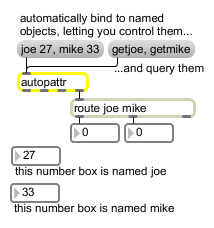Examples

Expose multiple objects in a patcher to the pattr system
| Name | Type | Opt | Description |
|---|---|---|---|
| object-name | symbol | opt | A symbol argument can be used to set the autopattr object's . In the absence of an argument, the autopattr object is given an arbitrary, semi-random name, such as u197000004. |
| bang | A is passed through the autopattr object and output from its center right outlet. | |
| int | input [int] |
An is passed through the autopattr object and output from its center right outlet. |
| float | input [float] |
A is passed through the autopattr object and output from its center right outlet. |
| list | input [list] |
A is passed through the autopattr object and output from its center right outlet. |
| anything | input/arguments [list] |
Any is analyzed. If the first element of the matches the name of an object maintained by the autopattr, the subsequent arguments in the set that object's value. If the first element of the matches (name), where (name) matches the name of an object maintained by the autopattr, the value of that object is sent from the autopattr object's right outlet, prepended by the object's name. Otherwise, the is passed through the autopattr object and output from its center right outlet. |
| getattributes | Causes a list of all objects names maintained by the autopattr object to be output from the right outlet, prepended by the symbol . | |
| getstate | Causes a series of lists to be output from the autopattr object's right outlet, one for every object maintained by the autopattr. Each list begins with the name of the object, and is followed by the object's current value. |
| Name | Type | g/s | Description |
|---|---|---|---|
| autoname | int | The word , followed by a 1 or 0, enables or disables the autopattr object's autoname state. The default is 0 (off). When enabled, the autopattr object will automatically name any unnamed objects in the patcher supported by the pattr system and bind to them, if possible. Naming only occurs when the patcher loads, when the autopattr object is reinstantiated, or when the autopattr object receives the message . New objects placed in a patcher after the autopattr has been instantiated will not be autonamed until one of these conditions is met. | |
| autorestore | int | The word , followed by a 1 or 0, enables or disables the autopattr object's autorestore state. The default is 1 (on). When enabled, the autopattr object will automatically output its last-saved values when the patcher is loaded, and distribute them to bound objects. Values are saved whenever the patcher is saved. | |
| dirty | int | The word , followed by a 1 or 0, enables or disables the patcher-dirty flag. The default is 0 (disabled). When enabled, the autopattr object will dirty the patch whenever its state changes. | |
| greedy | int | The word , followed by a 1 or 0, enables or disables the attribute-gathering feature of the autopattr object. The default is 0 (disabled). When enabled, any internal attributes of objects attached to the left outlet of the autopattr object will be exposed to the pattr system (as well as the normal value, if present). | |
| name | symbol | The word , followed by a symbol, sets the autopattr object's patcher name. |

| Name | Description |
|---|---|
| pattr | Patcher-specific, named data wrapper |
| pattrforward | Send any message to a named object in the patcher hierarchy |
| pattrhub | Access all of the pattr objects in a patcher |
| pattrmarker | Create pattr 'share points' and communicate between patcher hierarchies |
| pattrstorage | Save and recall presets of pattr data |
| Max pattr Tutorial 2: Automatic Bindings and Storage | Max pattr Tutorial 2: Automatic Bindings and Storage |